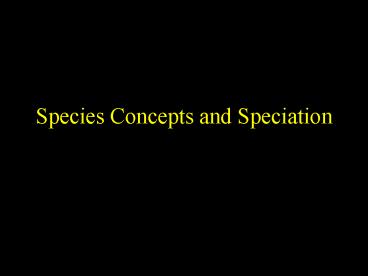Species Concepts and Speciation - PowerPoint PPT Presentation
1 / 18
Title:
Species Concepts and Speciation
Description:
Existence of a limited number of universals. No regard to variation in a species ' ... Limits to variation within a species. Non-Evolutionary Approaches III ... – PowerPoint PPT presentation
Number of Views:138
Avg rating:3.0/5.0
Title: Species Concepts and Speciation
1
Species Concepts and Speciation
2
Non-Evolutionary Approaches I
- Typological Species Concept species are a 'type'
of organismPlato - Existence of a limited number of universals
- No regard to variation in a species
- "Species are as many as were created in the
beginning by the Infinite." (Linnaeus, 1758)
3
Non-Evolutionary Approaches II
- Essentialism
- Similar to typological thinking
- Species consist of individuals sharing the same
essence - Species are separated by sharp discontinuity
- Each species is constant through time
- Limits to variation within a species
4
Non-Evolutionary Approaches III
- Nominalistic
- Only Individuals exist
- There are no real universals
- Popular in France in late 1800s
- Nature produces individuals and nothing moreno
species. - Species are only mental constructs
5
Species Concepts Based in Evolution
- The lineage species concept.
- A single species forms an evolutionary lineage
separated from other species. - They are not in genetic contact with other
species - Therefore, the concepts you may have learned are
actually criteria for determining the split
between species.
6
Biological Species Criterion (Concept)
- Species are groups of actually or potentially
interbreeding natural populations, which are
reproductively isolated from other such groups
(Mayr, 1940).
7
Problems with the BSC
- What do you do with asexual organisms, and what
do you do with organisms that occasionally form
hybrids with one another? Other difficulties
include - What is meant by potentially interbreeding
- Fossils---for example, it is not really possible
(or very meaningful!) to figure out whether a
trilobite living 300 million years ago would have
interbred with its ancestor living 310 million
years ago.
8
Evolutionary species criterion (concept)
- Evolutionary species concept A species is a
single lineage of ancestor-descendant populations
which maintain its identity from other such
lineages and which has it own evolutionary
tendencies and historical fate (Simpson, 1961
Wiley, 1981). - Difficult to apply, so we use the following
9
Phylogenetic species criterion (concept)
- A species is the smallest diagnosable cluster of
individual organisms within which there is a
parental pattern of ancestry and descent
(Cracraft 1983).
10
Other criteria (concepts)
- Cohesion species concept A species is the most
inclusive group of organisms having the potential
for genetic and/or demographic exchangeability.
(Templeton, 1989) - Ecological species concept A species is a set of
organisms exploiting (or adapted to) a single
niche (Ridley 1993). - Recognition species concept A species is the
most inclusive population of individual
biparental organisms which share a common
fertilization system. (as defined by Paterson,
1985 in Templeton, 1989). - Isolation species concept Species are systems of
populations the gene exchange between these
systems is limited or prevented by a reproductive
isolating mechanism or perhaps by a combination
of several such mechanisms. (as defined by
Dobzhansky 1970 in Templeton, 1989)
11
Now that we know some concepts, how does
speciation occur?
- Geographic Isolation
- A physical barrier (mountain, river etc.) reduces
gene flow - Poor habitat separating organisms
- From http//evolution.berkeley.edu/evosite/evo101
/VC1eSympatric.shtml
12
Reduction of Gene Flow
- Physical barrier
- Or no contact at the edges of a large range
13
On a phylogeny a node indicates a speciation even
14
Modes of speciation I Allopatric
- In this mode of speciation, something extrinsic
to the organisms prevents two or more groups from
mating with each other regularly, eventually
causing that lineage to speciate. Isolation might
occur because of great distance or a physical
barrier, such as a desert or river, as shown
below.
15
Modes of speciation II Peripatric
- An isolated group is severed from the original
population - Rare genes move to fixation
- If these genes are associated with reproduction,
sexual selection takes over, then speciation has
occurred as they may not mate with the original
population
16
Modes of speciation III Parapatric
- In parapatric speciation there is no specific
extrinsic barrier to gene flow. - The population is continuous, but nonetheless,
the population does not mate randomly. - Individuals are more likely to mate with their
geographic neighbors than with individuals in a
different part of the populations range. - In this mode, divergence may happen because of
reduced gene flow within the population and
varying selection pressures across the
populations range.
17
We may be observing the first steps of
parapatric speciation in the grass species
Anthoxanthum odoratum
Evolved different flowring times due to natural
selection from waste
18
Modes of speciation IV Sympatric
- Unlike the previous modes, sympatric speciation
does not require large-scale geographic distance
to reduce gene flow between parts of a
population. - How could a randomly mating population reduce
gene flow and speciate? Merely exploiting a new
niche may automatically reduce gene flow with
individuals exploiting the other niche. - This may occasionally happen when, for example,
herbivorous insects try out a new host plant.

